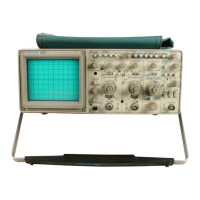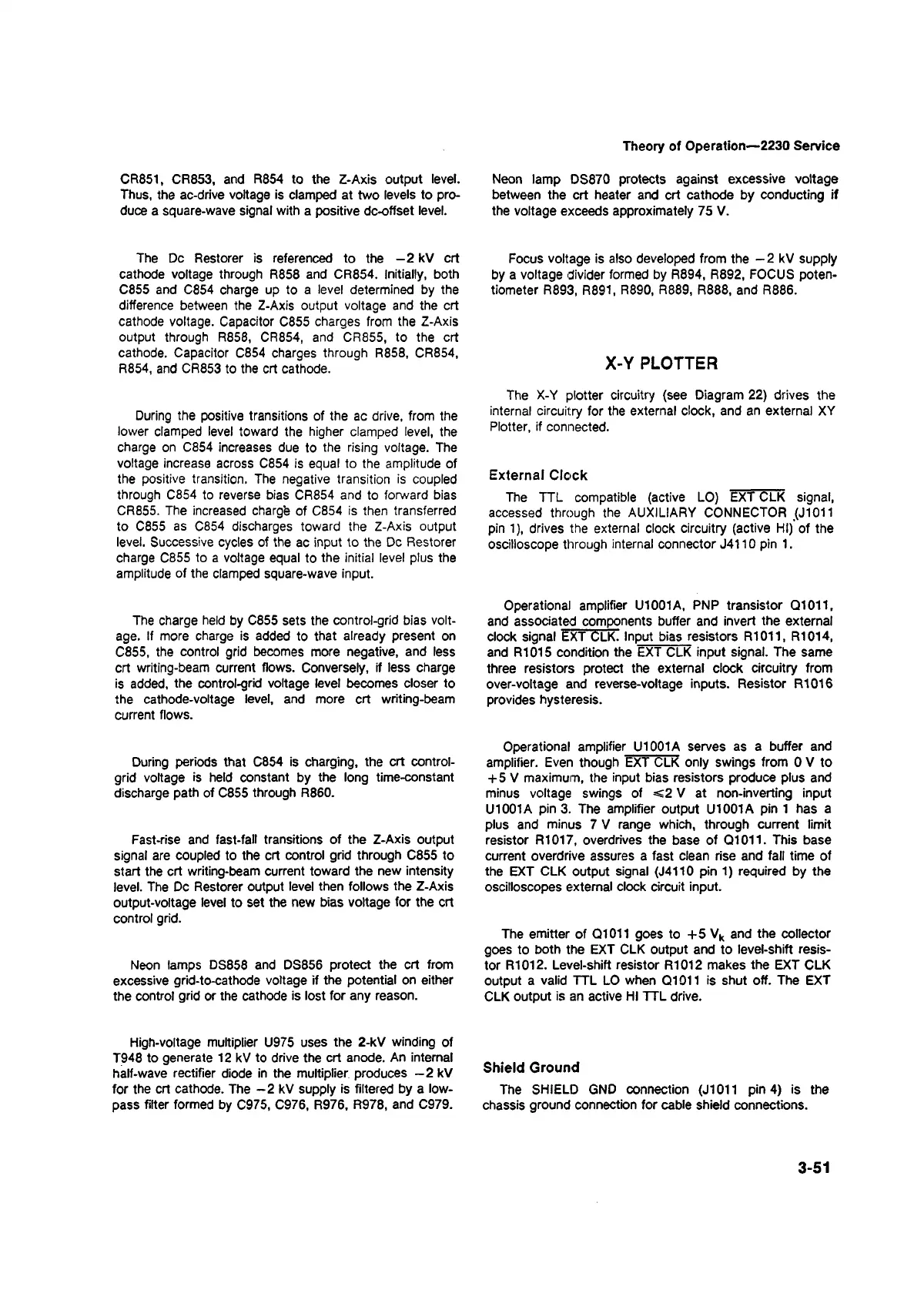Theory of Operation—2230 Service
CR851, CR853, and R854 to the Z-Axis output level.
Thus, the ac-drive voltage is clamped at two levels to pro
duce a square-wave signal with a positive dc-offset level.
The Dc Restorer is referenced to the — 2 kV crt
cathode voltage through R858 and CR854. Initially, both
C855 and C854 charge up to a level determined by the
difference between the Z-Axis output voltage and the crt
cathode voltage. Capacitor C855 charges from the Z-Axis
output through R858, CR854, and CR855, to the crt
cathode. Capacitor C854 charges through R858, CR854,
R854, and CR853 to the crt cathode.
During the positive transitions of the ac drive, from the
lower clamped level toward the higher clamped level, the
charge on C854 increases due to the rising voltage. The
voltage increase across C854 is equal to the amplitude of
the positive transition. The negative transition is coupled
through C854 to reverse bias CR854 and to forward bias
CR855. The increased chargfe of C854 is then transferred
to C855 as C854 discharges toward the Z-Axis output
level. Successive cycles of the ac input to the Dc Restorer
charge C855 to a voltage equal to the initial level plus the
amplitude of the clamped square-wave input.
The charge held by C855 sets the control-grid bias volt
age. If more charge is added to that already present on
C855, the control grid becomes more negative, and less
crt writing-beam current flows. Conversely, if less charge
is added, the control-grid voltage level becomes closer to
the cathode-voltage level, and more crt writing-beam
current flows.
During periods that C854 is charging, the crt control-
grid voltage is held constant by the long time-constant
discharge path of C855 through R860.
Fast-rise and fast-fall transitions of the Z-Axis output
signal are coupled to the crt control grid through C855 to
start the crt writing-beam current toward the new intensity
level. The Dc Restorer output level then follows the Z-Axis
output-voltage level to set the new bias voltage for the crt
control grid.
Neon lamps DS858 and DS856 protect the crt from
excessive grid-to-cathode voltage if the potential on either
the control grid or the cathode is lost for any reason.
High-voltage multiplier U975 uses the 2-kV winding of
T948 to generate 12 kV to drive the crt anode. An internal
half-wave rectifier diode in the multiplier produces — 2 kV
for the crt cathode. The — 2 kV supply is filtered by a low-
pass filter formed by C975, C976, R976, R978, and C979.
Neon lamp DS870 protects against excessive voltage
between the crt heater and crt cathode by conducting if
the voltage exceeds approximately 75 V.
Focus voltage is also developed from the - 2 kV supply
by a voltage divider formed by R894, R892, FOCUS poten
tiometer R893, R891, R890, R889, R888, and R886.
X-Y PLOTTER
The X-Y plotter circuitry (see Diagram 22) drives the
internal circuitry for the external clock, and an external XY
Plotter, if connected.
External Clock
The TTL compatible (active LO) EXT CLK signal,
accessed through the AUXILIARY CONNECTOR (J1011
pin 1), drives the external clock circuitry (active HI) of the
oscilloscope through internal connector J4110 pin 1.
Operational amplifier U1001A, PNP transistor Q1011,
and associated components buffer and invert the external
clock signal EXT CLK. Input bias resistors R1011, R1014,
and R1015 condition the EXT CLK input signal. The same
three resistors protect the external clock circuitry from
over-voltage and reverse-voltage inputs. Resistor R1016
provides hysteresis.
Operational amplifier U1001A serves as a buffer and
amplifier. Even though EXT CLK only swings from 0 V to
+5 V maximum, the input bias resistors produce plus and
minus voltage swings of <2 V at non-inverting input
U1001A pin 3. The amplifier output U1001A pin 1 has a
plus and minus 7 V range which, through current limit
resistor R1017, overdrives the base of Q1011. This base
current overdrive assures a fast clean rise and fall time of
the EXT CLK output signal (J4110 pin 1) required by the
oscilloscopes external clock circuit input.
The emitter of Q1011 goes to +5 Vk and the collector
goes to both the EXT CLK output and to level-shift resis
tor R1012. Level-shift resistor R1012 makes the EXT CLK
output a valid TTL LO when Q1011 is shut off. The EXT
CLK output is an active HI TTL drive.
Shield Ground
The SHIELD GND connection (J1011 pin 4) is the
chassis ground connection for cable shield connections.
3-51

